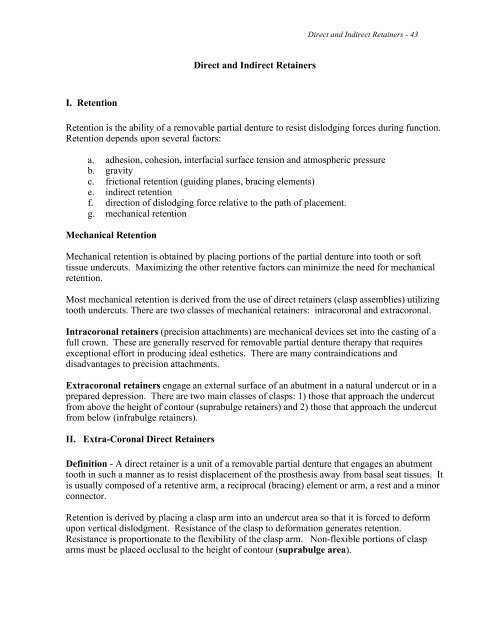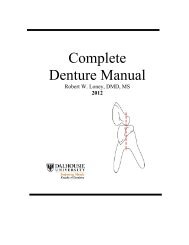RPD Manual 11 - Removable Prosthodontics - Dalhousie University
RPD Manual 11 - Removable Prosthodontics - Dalhousie University
RPD Manual 11 - Removable Prosthodontics - Dalhousie University
Create successful ePaper yourself
Turn your PDF publications into a flip-book with our unique Google optimized e-Paper software.
I. Retention<br />
Direct and Indirect Retainers<br />
Direct and Indirect Retainers - 43<br />
Retention is the ability of a removable partial denture to resist dislodging forces during function.<br />
Retention depends upon several factors:<br />
a. adhesion, cohesion, interfacial surface tension and atmospheric pressure<br />
b. gravity<br />
c. frictional retention (guiding planes, bracing elements)<br />
e. indirect retention<br />
f. direction of dislodging force relative to the path of placement.<br />
g. mechanical retention<br />
Mechanical Retention<br />
Mechanical retention is obtained by placing portions of the partial denture into tooth or soft<br />
tissue undercuts. Maximizing the other retentive factors can minimize the need for mechanical<br />
retention.<br />
Most mechanical retention is derived from the use of direct retainers (clasp assemblies) utilizing<br />
tooth undercuts. There are two classes of mechanical retainers: intracoronal and extracoronal.<br />
Intracoronal retainers (precision attachments) are mechanical devices set into the casting of a<br />
full crown. These are generally reserved for removable partial denture therapy that requires<br />
exceptional effort in producing ideal esthetics. There are many contraindications and<br />
disadvantages to precision attachments.<br />
Extracoronal retainers engage an external surface of an abutment in a natural undercut or in a<br />
prepared depression. There are two main classes of clasps: 1) those that approach the undercut<br />
from above the height of contour (suprabulge retainers) and 2) those that approach the undercut<br />
from below (infrabulge retainers).<br />
II. Extra-Coronal Direct Retainers<br />
Definition - A direct retainer is a unit of a removable partial denture that engages an abutment<br />
tooth in such a manner as to resist displacement of the prosthesis away from basal seat tissues. It<br />
is usually composed of a retentive arm, a reciprocal (bracing) element or arm, a rest and a minor<br />
connector.<br />
Retention is derived by placing a clasp arm into an undercut area so that it is forced to deform<br />
upon vertical dislodgment. Resistance of the clasp to deformation generates retention.<br />
Resistance is proportionate to the flexibility of the clasp arm. Non-flexible portions of clasp<br />
arms must be placed occlusal to the height of contour (suprabulge area).















